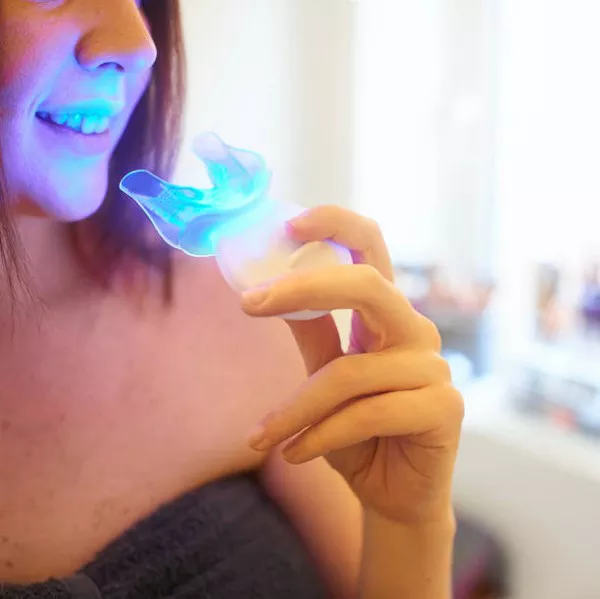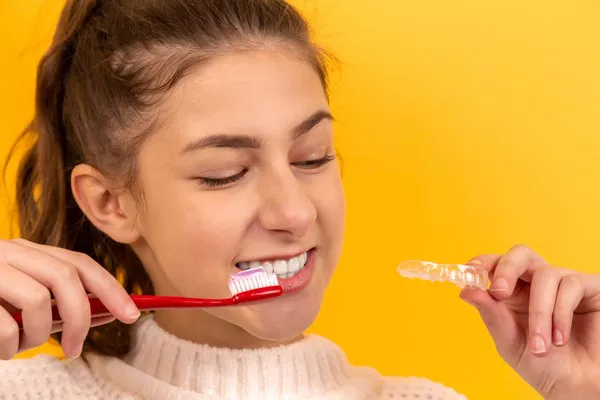With the rapid development of the economy and the improvement of people’s living standards, patients with malocclusion have higher and higher requirements for the aesthetics of orthodontic treatment, and clinical technologies such as ceramic brackets and lingual orthodontics have appeared successively.
However, the ceramic bracket has some problems, such as poor aesthetics, need to replace the labial arch wire, insufficient strength of the bracket, and difficulty in re-bonding after falling off, while the lingual appliance has a relatively large impact on pronunciation, poor comfort, and is not good for patients to maintain good oral hygiene.
The orthodontic invisible appliance without brackets can meet the aesthetic requirements of orthodontic treatment. It is a series of personalized transparent appliances made according to the digital dentition model and tooth movement design scheme.
The prototype of bracket less invisible appliance was the orthotopic appliance invented by American doctor Kesling in the 1940s. After decades of development, more than 30 companies have produced bracket less invisible appliance, and continue to carry out material and system innovation, gradually expanding the scope of malocclusion correction.
At present, no bracket invisible appliance can be used for reduction treatment.
For patients with severe dentition crowding and large protrusion, personalized reduction method, such as reduction of a single lower incisor, 2 premolars or 4 premolars, can obtain satisfactory curative effect.
1. Indications for subtractive therapy of orthodontic technology without brackets and strict screening of subtractive patients are the prerequisite for achieving satisfactory curative effect.
At present, most of the patients with reduced number can obtain satisfactory results by the no-bracket invisible correction technology.
However, for beginners or newly opened practitioners, it is recommended to select patients with severe crowding of class ¢¡ malocclusion for reduction therapy. After reducing the number of premolars in such patients, with the relief of crowding, the extraction gap can be closed quickly or only a small amount of gap is left.
It has low biomechanical requirements for the overall adduction of anterior teeth in the late treatment, and the expected effect is easier to achieve.
For the reduced patients with sharp facial shape but not with dentition crowding, physicians should consider the biomechanical principle of anterior tooth adduction during the design of the program and the whole treatment process, do a good job in the control of anterior tooth torque, and have the ability of offtrack treatment to ensure good efficacy.
For oseous deformity, open tooth, counter, temporomandibular joint disorder disease and periodontal disease and the reduction of patients, physicians should be careful and reasonable use of additional rectification device implants, such as bow and section) and multidisciplinary joint treatment, completes the correctional treatments before, and after the treatment for control and monitoring, in order to obtain good orthodontic curative effect.
2. The biomechanical design of the pitchless invisible appliance for reduction therapy is different from the force application method of the fixed appliance. The pitchless invisible appliance generates pressure or thrust on the tooth to achieve tooth movement through the deformation of the appliance.
For the majority of patients with reduced premolars, the reduced premolars can provide space and space for the crowded or protrusive anterior teeth. Therefore, the rational design of anchorage and tooth movement mode is crucial for the orthodontic effect.
Taking adductive anterior teeth of reduced first premolars as an example, this paper discusses the biomechanical design of no-bracket invisible orthodontic technology for reduced patients.
For patients who need to strengthen the anchorage of the posterior teeth, a vertical rectangular attachment can be designed on the crown of the posterior teeth to prevent the mesial tilt of the crown of the posterior teeth to a certain extent and play a role in strengthening the anchorage.
In recent years, optimized anchorage appendages with smaller volume than traditional rectangular ones have appeared in the market. Placed at the proximal buccal apex of the crown of the posterior teeth, they can produce a clockwise moment to the posterior teeth and also play the role of strengthening the anchorage.
For patients with a very high demand for anchorage, physicians can also implant additional anchorage implants to connect the implant to the posterior teeth to further strengthen the anchorage of the posterior teeth.
In the process of distal movement of the cusp, it is necessary to ensure the overall parallel movement of the cusp as far as possible to prevent oblique movement, so as to ensure good root parallelism after treatment.
To achieve this purpose, can design on the tooth pairs of adduction attachments, one is located at near buccal pointed teeth, another is located in the fangs far cheek place, can produce a counterclockwise torque, against pointed to the applied force in developing crowns on far clockwise torque, finally realizes the fangs of the whole parallel move and get a good parallelism root.
For patients who need to design class ¢¢ traction, there is a spatial conflict between class ¢¢ traction retractor and adduction attachment at the proximal buccal gingiva of canines. Physicians can replace adduction attachment with precision cutting retractor at the proximal buccal gingiva.
The technician adjusted the shape and position of the remaining optimized adduction appendage according to the requirements of the physician to ensure the balance of the whole force system.
In addition, the power arm can also be designed on the cusp and the second premolar to move the distal force of the cusp through the center of resistance, so that the overall parallel movement of the cusp can be achieved.
In the process of incisor adduction, the incisor has a tendency of crown receding because the invisible appliance without brackets can only apply adduction force on the crown.
For patients with upright anterior incisors, a power ridge can be designed on the invisible appliance without brackets to prevent the incisors from receding when the anterior teeth are adducted. The power ridge is located in the depression of the anterior teeth neck of the appliance, which is generally placed on the lip side, or tongue side in special cases, or both sides.
The pressure ridge exerts a counterclockwise torque on the incisor neck, which counteracts the clockwise torque during adduction of the anterior teeth and avoids the inclination during adduction of the incisor teeth.
The SmartForce system can also optimize the tooth movement path by analyzing the results of big data research.
In addition, the shape of the appliance can also be changed according to the different stages of the treatment to control the unnecessary deepening of the anterior teeth during the process of adduction and to prevent the control of the torque of the anterior teeth.
For the patients whose anterior incisors are inclined to the lip, good treatment results can be achieved without special design.
3. Clinical experience of non-brackets invisible-based orthodontic technique for subtractive treatment in China there are many patients with occlusal crowding. Many patients with class ¢¢ or ¢£ malocclusion need to obtain clearance, align the crowded dentition or correct the convexity of adductive anterior teeth by subtractive treatment.
The author applied the no-bracket invisible correction technology with traditional rectangular attachment, traction arm or optimized attachment system, and achieved good results.
In general, it is recommended to use the traction arm for patients with bimaxillary protrusion, because various forms of traction can be flexibly carried out between the traction arm, between the traction arm and the retractor of the invisible appliance without brackets, and between the traction arm and the lingual buckle glued on the tooth surface, which is convenient to adjust the midline and occlusal relationship and make fine adjustment.
In addition, the force point of the traction arm is higher, which is generally located in the resistance center of the tooth, so parallel tooth movement can be realized.
However, the traction arm needs to be glued to the tooth surface with a metal retractor, which affects the appearance. At the same time, the patient needs to closely cooperate with the rubber band for traction.
This requires the physician to fully communicate with the patient before the treatment to obtain their understanding and cooperation.
For patients with large dentition crowding and posterior tooth movement less than 2 mm, it is recommended to use the optimized accessory system.
An optimized adduction attachment was set on the cusp and an optimized anchorage attachment was set on the posterior teeth. The appliance itself had some deformation, which could resist the unnecessary elongation and torque loss of the anterior teeth during adduction.
The appendage of the system is small and beautiful, but if the appendage falls off and is not found in time, the teeth may move out of control and degloving.
Therefore, patients should be taught to identify attachments, observe carefully every day, and deal with problems in time.
At the same time, the doctor should also carefully observe the patient during the return visit, so as to find the attachment falling off or damaged in time and deal with it accordingly.
The optimized accessory system combined with implant anchorage reduction was used to correct the occlusion of class ¢¢ malocclusion with anterior teeth. The comparison before and after treatment showed that the occlusion was corrected and the patient’s profile was well improved.
4. Precautions for the application of pitchless invisible correction technology in reduction therapy three important problems in reduction therapy are anchorage control, torque control and vertical control.
1) Anchorage control: physicians are required to make a correct diagnosis, accurately assess the complexity of the malformation of patients, and make necessary anchorage design.
There are many ways to strengthen anchorage of non-bracket invisible orthodontic technology, including step by step or step by step, adding accessories to strengthen retention, using traction, and matching with implant anchorage. It can be used according to clinical needs.
Among them, moving teeth in steps or sections is the most used in the design.
Treatments without braces stealth technology can do only a one or a few teeth, while the other does not move as the palatal teeth, for example, when you receive front teeth can design mobile teeth before they move incisor, one-third or fangs mobile first, then cut tooth and tooth adduction at the same time, the advantage of this way of moving is the reaction of posterior teeth small, consume less resistance.
For example, when opening the occlusal, the mandibular cusp is usually designed first, and the other teeth are used as anchorage.
After the mandibular cusps were moved to the position, the four lower incisors were pressed after the teeth were closed.
In addition, the method of alternately lowering the cusp and the 4 lower incisors can also be designed to achieve the flattening of the jaw curve.
In this process, attachments with strong retentive force should be designed on other non-moving premolars, such as wedge attachments, to ensure that the anterior segment of the appliance will not deform and depress the anterior teeth, so as to achieve predetermined tooth movement.
2) Torque control: if the patient’s anterior teeth are inclined to the lip before treatment, special torque control is generally not necessary in the process of reduction and adduction;
However, if the patient’s anterior teeth are upright and the amount of adduction is large before treatment, appropriate torque control should be carried out to avoid unnecessary anterior tooth retraction and deepening of overbite during adduction.
It can be simulated in 3D software, adding enough torque to the corresponding tooth for control at a certain stage, or designing pressure ridges on the anterior teeth.
Orthodontists should carefully evaluate the final tooth status set by the software, especially the axial direction of the anterior teeth. They should not be too upright or introverted, otherwise, early contact of the anterior teeth and opening and closing of the posterior teeth may occur.
At the same time, it should be noted that the anterior teeth and posterior teeth should not be designed to move at the same time in the initial stage of treatment, which may lead to a similar “roller coaster effect” of fixed treatment technology, such as deepening overbite and opening of the posterior teeth.
When reviewing the treatment plan, special attention should be paid to the tooth movement assessment form to determine the three-dimensional movement direction and amount of each tooth.
3) vertical control: due to the treatments without braces stealth has certain thickness, so that more patients can appear after teeth down, even after the tooth even small open splint, usually don’t have to worry about, after the late malocclusion patients with teeth of vertical clearance can alleviate by oneself, and vertical traction when necessary orthodontic tooth or open.
Because of this feature, the non-bracket invisible correction technique is relatively more effective in the control of high Angle cases with large mandibular plane Angle.
It is necessary to pay special attention to the vertical control of the patients with class ¢¢ malocclusion with open occlusion. It can reduce the open occlusion of the anterior teeth by lowering the posterior teeth appropriately, and make the mandible rotate forward at the same time. The appearance of the chin is relatively good, which is beneficial to improve the lateral appearance.
When there is a lot of posterior tooth compression required and it is difficult to achieve by the deformation of the appliance alone, the posterior tooth compression can also be achieved with anchorage implant and rubber band traction.
5. Limitations of subtractive treatment of orthodontic orthodontic techniques Although the orthodontic orthodontic system is personalized and accurate, the actual tooth movement of orthodontic orthodontic is not consistent with the expected tooth movement because the resistance center information of individual teeth is not used and the alveolar bone remodeling rate of different individuals is different.
Recent studies have shown that non-bracket invisible orthodontics can achieve 60% of the expected overall tooth movement, with the highest efficiency of distal molars (80%) and the lowest efficiency of elongated molars (30%).
Degloving may occur in patients during the treatment process, that is, individual teeth cannot keep up with the expected tooth movement of the appliance, which is manifested as the appliance does not fit with the tooth and the gap is large.
For meiotic patients, the removal of the cusp occurs during the movement of the cusp.
A part of the appliance can be removed from the lip and tongue side of the cusp, and a resin lingual buckle can be glued. The cusp can be “held” into the appliance by a rubber band to catch up with the desired tooth movement of the appliance.
In short, treatments without braces stealth technology is a personalized, treatments of the high degree of accuracy, beautiful, although some deficiencies at present, but the thinking of orthodontic doctors can use fixed appliance technology during rectification scheme design carefully controlled, and in the process of rectification timely monitoring, timely processing to take off the set of phenomena in the process of rectification, generally a good anticipated effect can be obtained.
The non-bracket invisible appliance technology emphasizes the close cooperation of patients and the sequential wearing of appliances, which requires high compliance of patients.
On the other hand, the orthodontic invisible orthodontic technology without brackets requires doctors with rich clinical experience and enough foresight to predict the problems and details of the orthodontic treatment before the treatment, and to control them in the design of the scheme in order to achieve the ideal treatment effect.
With the continuous development of the correct theory of technology, the wide application of clinical, technical innovation and progress, without braces stealth rectification indications will continue to expand, in the future, without braces stealth treatments may become the development direction of orthodontic treatment technology.































